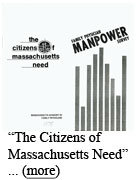Family Medicine Comes to Massachusetts
In Massachusetts, however, another five years were required for Family Medicine to become part of residency offerings in the state, and
even then, the new UMass Medical School was the only medical school willing to incorporate the new specialty. Three prestigious, private
medical schools
(Harvard, Boston University, and Tufts) were clustered inside the state's population center, Boston, and its suburbs. By the 1960s, all
of these schools encouraged their graduates to enter practice as specialists. Massachusetts had a higher than average proportion of
physicians to the general population. But maldistribution of physicians was becoming a recognized problem for the state due to a lack of
primary care practitioners in rural counties.(31) As a report prepared for the President of the
UMass system, Robert Wood, summed up the  situation in 1973, "Massachusetts ranks among the top ten states in every category in 15 of the 20 specialties. However… the
relative ranking of physicians engaged in general practice is 33rd. As will be shown below, this figure is significant for the type of
health care that will be required in the Commonwealth in the years ahead."(32) These data were based on a 1970
survey, but clearly the situation had not improved by 1973.
In October 1974, the Board of Governors of the Massachusetts Academy of Family Practice surveyed physicians
across the state to see "if there exists a deficit of primary care physicians, and if so, what the deficit is, and where it exists in
the Commonwealth."
situation in 1973, "Massachusetts ranks among the top ten states in every category in 15 of the 20 specialties. However… the
relative ranking of physicians engaged in general practice is 33rd. As will be shown below, this figure is significant for the type of
health care that will be required in the Commonwealth in the years ahead."(32) These data were based on a 1970
survey, but clearly the situation had not improved by 1973.
In October 1974, the Board of Governors of the Massachusetts Academy of Family Practice surveyed physicians
across the state to see "if there exists a deficit of primary care physicians, and if so, what the deficit is, and where it exists in
the Commonwealth."
Their survey defined "primary care" to encompass not only family physicians, but pediatricians, general internists, and osteopaths. The inventory, as of December 31, 1973, found 4240 primary care physicians, including 595 primary care residents (out of 2312 residents in all in MA) in active practice in Massachusetts, of whom 1124 were family physicians. But, one-third of the latter were over 60 years of age. Based on these criteria, there existed "a shortage of 1564 Family Physicians in Massachusetts … most prominent[ly] in Essex, Middlesex, and Worcester Counties." The ratio in Worcester was 19.7 per 100,000.(33) Between 1973 and 1975, in fact, the fate of the University of Massachusetts Medical School would become bound up with its willingness to promote primary care and especially Family Medicine. Thus, by 1973, it became apparent that the school would need to develop a more coherent and positive approach to increasing the numbers of family practitioners in the state.
Until the school formally created such a program, however, a small group of General-Practitioners-turned-Family-Physicians began to actualize the ideals of Family Medicine within their own private or community health center practices. In the towns and rural counties of Central and Western Massachusetts, some large practices still were led by doctors who had graduated before World War II and who had never felt the need to continue their postgraduate education (residency) beyond the internship year. Some of them were anxious to move beyond general practice and involved themselves at the level of their own state specialty societies. Dr. Robert Babineau, originally a GP and the founder of the Fitchburg residency, remembers this period of transition from the perspective of a Massachusetts general practitioner with a thriving practice and an active presence in the state's Academy of General Practice:
I'd been in practice from 1951. I got involved with the Massachusetts Academy of what was then called General Practice, you know, just to become involved in what was going on in the medical world, and over the '50s and early '60s, there was a big debate as you know about the future of general practitioners, because this was the era of specialties and everyone was beginning to specialize, in the '50s and '60s. So those of us who were family doctors (well, what we called ourselves then were GPs), thought that we should at least get involved in the discussion, because we felt that our type of practice made a lot of sense. You certainly needed specialists, but you also needed people who could kind of function as the primary care physician, to be the quarterback of the team, so called.
So we got involved in that and through that I got involved not only at the [national] level but at the state level, where we were having big discussions about the future of general practice, and through that … of course … the discussions then were about whether it should survive and those of us of course felt it should … [T]hen we had discussions about the name of this new group, and we didn't think "general practice"—it sounded too broad—so we had big discussions at the national level and state levels about the future, and that's when we decided to change the Academy. Along with those discussions were discussions that if we're going to survive, we need more training, so the residency issue was brought up along with the discussions about name change, and eventually we all decided that we needed to develop a residency program to train our future doctors, and we decided that they should be called "family physicians."(34)
